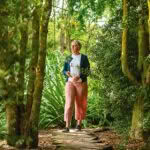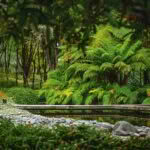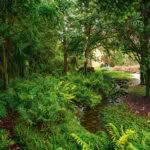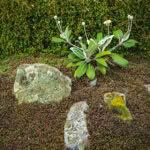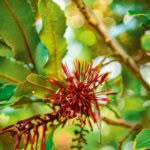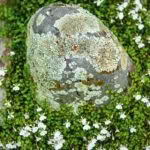Turning a clay pan into the extraordinary Japanese-inspired native garden, Moritaki
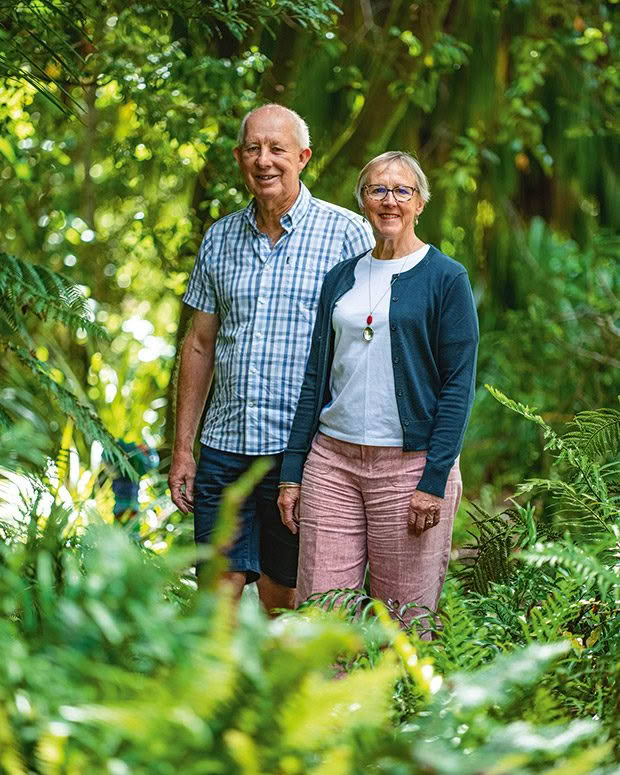
A lush garden in suburban Blenheim has sprung from crowbarred holes in a clay pan planted with native shrubs and trees. It’s taken Andrea and Pete Forrest two decades to create Moritaki — one of the stars of November’s Garden Marlborough event.
Words: Kate Coughlan Photos: Daniel Allen
Andrea and Pete Forrest are unsure why they decided to go totally native when developing a half-hectare two-section property in a new subdivision on the outskirts of Blenheim near the foothills of Wither Hills. It’s funny that they can’t recall what prompted such a big commitment. But they’ve stuck to it and, in so doing, become fond of the frailty, form and toughness of New Zealand’s unique plants.
“When we started 22 years ago, there weren’t many people with 100 per cent native gardens. We didn’t know any,” says Pete, who, like Andrea, can’t put his finger on what sparked the native-only plan. “We’d developed a lovely quarter-acre garden [about 1000 square metres] before this one, and it was a traditional rhodos-and-roses type,” says Andrea. “My mother lived in Christchurch, and her beautiful garden had a lot of ferns in it. So I was always fond of ferns; maybe that was something to do with it?”

Trunks of a putaputaweta, the marbleleaf (left), and a north island kōwhai (right) frame the view towards the lagoon at Moritaki. All rocks, stones and boulders were carted home by the Forrests after being found on their walks or friends’ farms. The exceptions are three large rocks at the head of the waterfall that required a crane for placement.
Pete says that outings with Andrea’s family always involved pinching ferns to take home to her mother’s garden. And, talking of family, it is Pete’s family history (he grew up near Koromiko between Picton and Blenheim) and the fact that his grandmother’s large property was entirely covered by arum lilies accounts for the only non-native interloper roaming beneath the Forrests’ trees. “Arums are almost native,” they say. “Old country properties always had a clump of arums somewhere.”
The couple set out to see what they could do with natives, and their garden, Moritaki, named for the Japanese concept of a water garden, evolved one crowbarred hole after another. Yes, that’s one thing upon which Pete is very clear. They were mad not to have checked the soil before purchasing the bare flat land. “Absolutely crazy,” he says. A casual jab with a garden fork would have revealed the challenge of a clay pan beneath a thin layer of topsoil. And, despite 22 years of composting with pine needles and pea straw, grape mulch and sheep pellets, the clay still rules.
- Plants have the right of way on this property, and trees are admired as much for their trunks as anything, especially those of the hoheria (lacebark) and horoeka (lancewoods).
- Andrea loves the way ferns drape elegantly over the boardwalk by the lagoon edge. Kānuka (in a stand beyond the lagoon) was chosen over mānuka as kānuka tends not to be blighted by sooty trunks; the small-leaved ground cover near the end of the walkway is Lobelia pedunculata and flowers almost year-round. It seems to love the open ground and is making its way into the sun among the rounded stones collected by the Forrests for their smooth look worn by millions of years tumbling down rivers.
- Garden designer Hiro Yoshida wanted the trees on the drive side of the stream to be removed. But Andrea and Pete couldn’t bring themselves to do so as the rewarewa and putaputaweta had taken so long to get established.
Every plant in this lush and glorious rendition of a native forest environment has its own hole especially dug for it by Pete with his crowbar. They’d better appreciate it. And every swathe of native ground cover such as leptinella or mazus (swamp musk) is meticulously hand-weeded by Andrea.
Don’t imagine, for one minute, that going native is to let the bush self-manage its own path to garden-hood. No way. And no wonder Pete (a retired accountant) is starving by morning tea time on gardening days and that Andrea is such an adept hand at morning glory muffins, their sustenance coming from a little bit of everything.
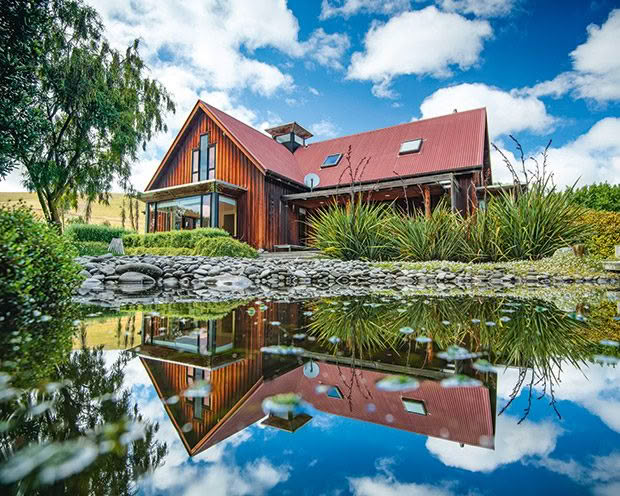
Water is visible from all living areas of the house, as decreed by the rules of a water garden. The Corokia buddleioides hedge is amenable to trimming to ensure it doesn’t impede the view.
As if that wasn’t enough of a challenge, there was also the subdivision’s unattractive habit of sending runoff water into the Forrests’ lowest lying areas — one of which is Andrea’s “dry stream”. It gets wickedly full of water from time to time, requiring a small submersible pump concealed in a mini wine barrel (in a nod to another branch of the Forrest family and their skill with grapes) to return the creek to the desired dry state. Mind you, in another area, that persistent dampness has done well to keep the toes of the kahikatea trees damp, just as they like it, and that saves Pete a lot of time with his hose.
This hose habit is one Andrea finds a little too much. “But you know a man, he has his mind set on something, and you can’t change it.” On the other hand, Pete wishes a few minds would change about the coming water reform proposals, which are likely to see Blenheim residents pay for water for the first time. He fears it might spell tough times for his native plants, which have happily bathed in the spray of his generous watering over the decades.
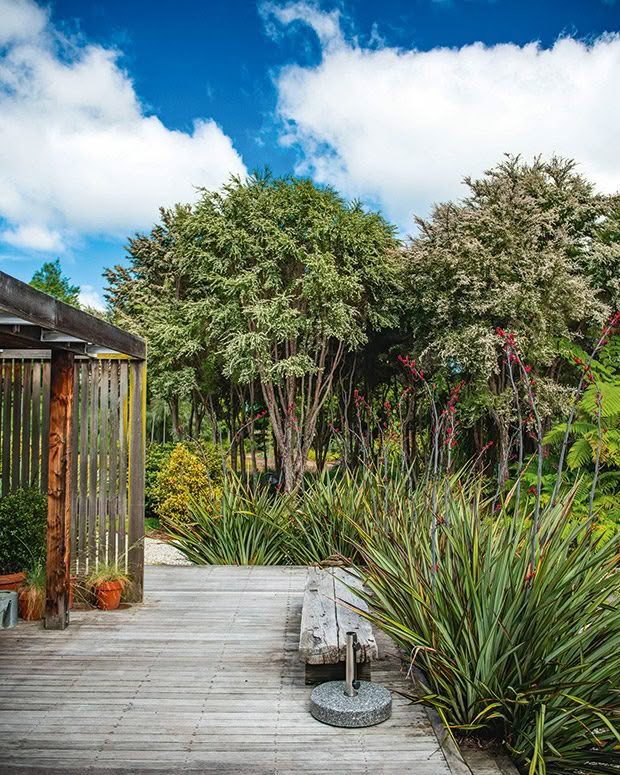
Native gardens tend to have modest flowers, yet the fiery flower spikes of the harakeke (Phormium tenax, this one called ‘Surfer’) and the kānuka (Kunzea ericoides) generally burst into bee-pleasing glory in late spring, often after Garden Marlborough has ended. Pete, the diligent waterer, is happy that the harakeke tolerates neglect and dry conditions.
Natives flourish with moisture, he reckons, and they look all the better for it, too. Foliage, particularly. And the foliage is the starring element in this garden and has informed how it is planted. Nothing becomes leaves more than a glistening sheen of water.
However, Blenheim’s 600-millilitre annual rainfall (falling 45 to 60 millilitres every month as regular as clockwork, notes Pete) will not be enough to keep the plants in the moistened luxury to which they’ve become accustomed. A problem yet to be solved. And don’t all gardeners know that there are always challenges ahead?
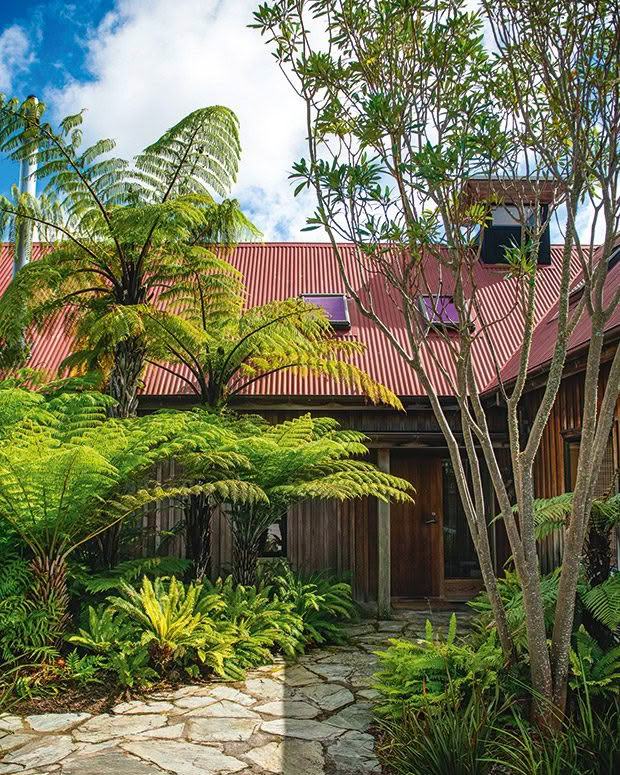
Tree ferns, black mamaku and a pseudopanax underplanted with found ferns soften the entrance to the Forrests’ low-maintenance home built 20 years ago.
One clever aspect of Pete and Andrea’s planting is the number of forest giant species used, planted as small saplings into crowbarred holes. Neither were deterred by them being among the world’s slowest-growing trees. Initially, they planted the Hoheria populnea (native lacebark) and the non-native Cytisus proliferus (tree lucerne) as fast-growing nursery trees to shelter the slower-growing larger trees.
Now, after nearly a quarter of a century, the statuesque podocarps (rimu, kauri, kahikatea, lancewood and rewarewa) and beeches (mountain and silver) give shade and protection to the shorter-lived under-storey species, including nīkau, kānuka, cabbage trees, native brooms and ferns of all variety, including mamaku and silver ferns. If they’d grown only native shrubs, their garden would not have developed such an authentic forest-like feeling of a natural environment. Nor would it be long-lived as native shrubs, which unlike their giant tree cousins, have short life spans.
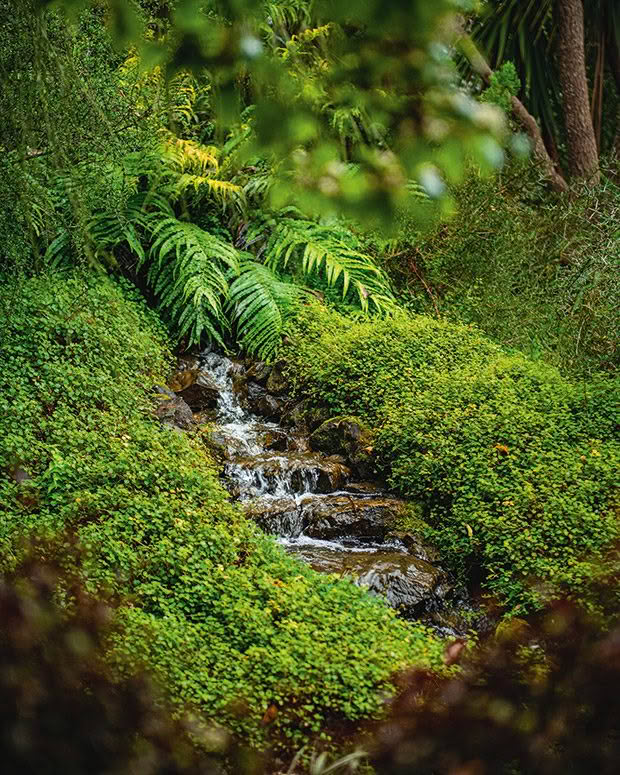
The creek appears to dance down stone steps between green banks of a native fuschia groundcover, chosen for its low growing habit so the water is always visible from the house, an important element in a Japanese water garden.
But perhaps the highlight of all the many achievements at Moritaki is the mountains-to-the-sea water garden, designed by a Japanese landscaper whom Andrea met casually while visiting her mother in Christchurch.
Andrea, already intrigued by the principles with which the Japanese bring order and calm into their gardens — hence the (sometimes disobediently wet) dry stream — made friends with the landscaper, Hiro Yoshida, and discussed goals for her Blenheim property. She was taken aback some months later to receive an email stating he was on his way from Japan to design her garden.
Pete freaked out, his first thought being, “Oh Lord, how much is this going to cost me, this man coming from Japan to design my garden?”
“As an accountant, that’s the first thing he thinks of: ‘How much is this going to cost me?’” says Andrea.
- Marlborough rock daisies are a favourite for their large leaves, attractive furry undersides, largish flowers and ability to grow in hot, dry places. That was until they outgrew their garden, colonized the drive and blocked Pete’s boat access.
- The rewarewa is high in Andrea’s affection for its sparkly foliage and dewy water-sparkled look, not to mention its extravagant flowers,
- The lichen-encrusted boulder lives happily among a nest of Andrea’s favourite flowering groundcover Leptinella dioica.
“Fortunately,” says Pete, “he just wanted a few days skiing at Rainbow Ski Field, so all good.”
“All good?” It’s such an understatement for the wonders of the design, which sees a small stream emerging from the “mountains”, burbling and chortling over boulders and stones to the “sea”.
It is not only Andrea and Pete enjoying the show, but appreciative birds come to bathe, drink, chirp and chortle on the beach. Tūī arrived a few years ago (perhaps attracted by the pair of taylor’s gold kōwhai bushes that flower profusely through the darkest days of winter). Bellbirds, too, are regulars now. And frogs like to spend their summers here.
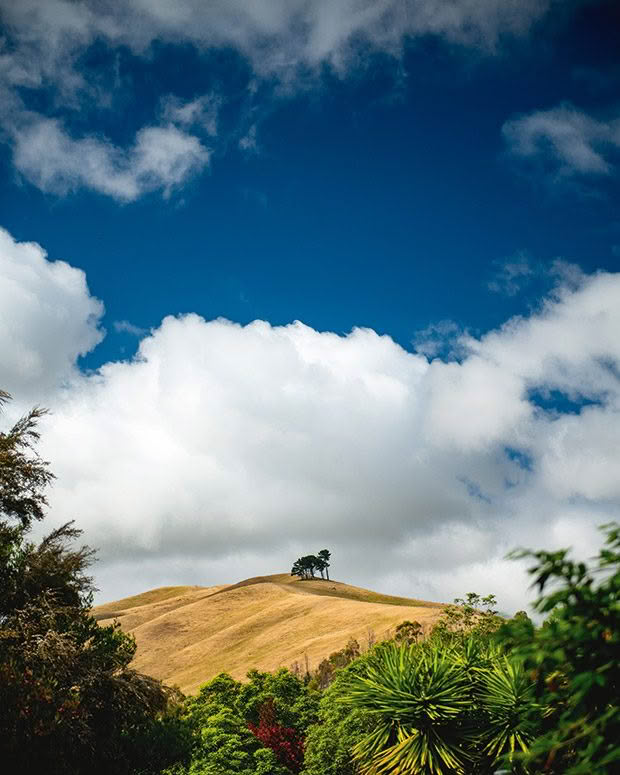
The barren Wither Hills, to the south of the property, provide a startling contrast to the evergreen nature of the garden and illustrate how successful the native-only planting regime has been.
This very clever water garden contains many contrasting visual elements, such as the fast- and slow-flowing water. Sometimes the stream burbles; in other areas, as in the pond, it is silent. There are rough mountain rocks and smooth beach pebbles; small mountain plants line the stream’s path down the mountain, while lush and large ferns droop their elegant foliage towards the still lagoon waters. It’s a triumph.
And one that Pete and Andrea say enhances their sense of wellbeing and happiness daily. Just as the clever designer knew it would when he positioned it to be connected to all the living areas of their home.
“The Japanese are rather beautiful in their thinking about gardens,” says Andrea, whose own thinking is also rather beautiful. And Pete observes that when he returns from holiday, he often wonders why he left this paradise at all.
VISIT MORITAKI
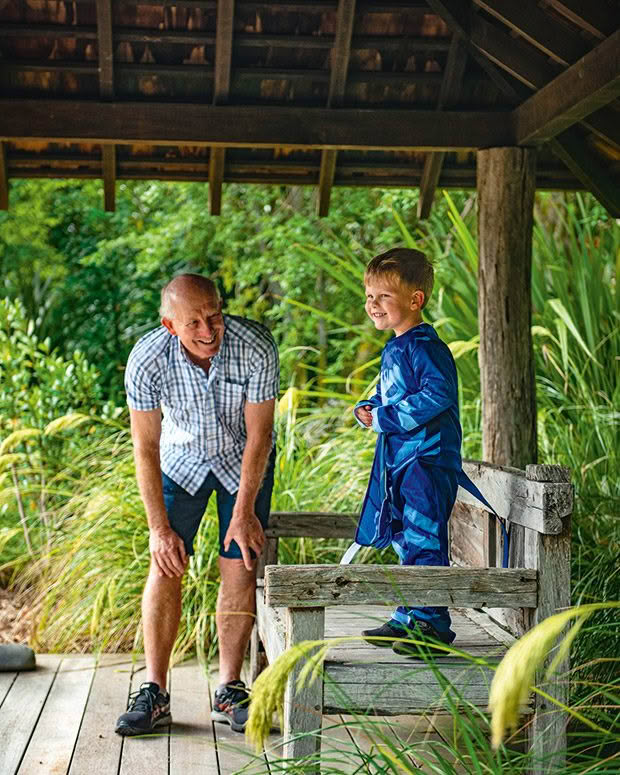
Grandson Macklin Forrest lives locally and is a regular visitor to the garden.
Moritaki is one of the dozens of beautiful Marlborough gardens featuring in this year’s Raupara Springs Garden Marlborough. This famous extravaganza runs from 3 to 6 November and includes tours, workshops and a speaker series starring Australia’s legendary landscape designer Paul Bangay. Book tickets at gardenmarlborough.co.nz
ANDREA’S GARDEN PICKS
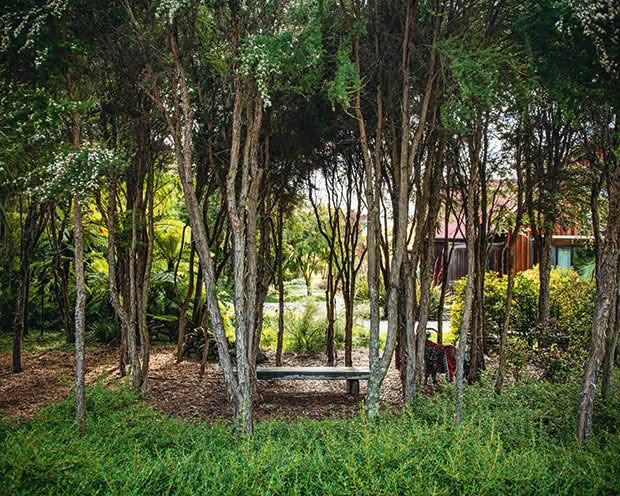
A ground cover of Coprosma kirkii sprawls happily among the trunks of the kānuka.
“The trick to creating lovely ‘flower’ arrangements from a native-only garden is using a mix of foliage, as natives seldom have big, beautiful blooms. Try a contrasting collection of leaf sizes and textures, such as a combination of wispy and floppy foliage such as broom, flax or protrate kōwhai. This makes a lovely casual, free-form display. I find virtually any native leaf forms a good backdrop for a vase, but ferns are the queens of foliage.
“The only native flower I use in a vase by itself is the hebe, and there certainly is a wide variety of them.” Andrea and Pete’s favourite natives are marlborough rock daisies, lancewoods and rewarewa.
Love this story? Subscribe now!
 This article first appeared in NZ Life & Leisure Magazine.
This article first appeared in NZ Life & Leisure Magazine.
